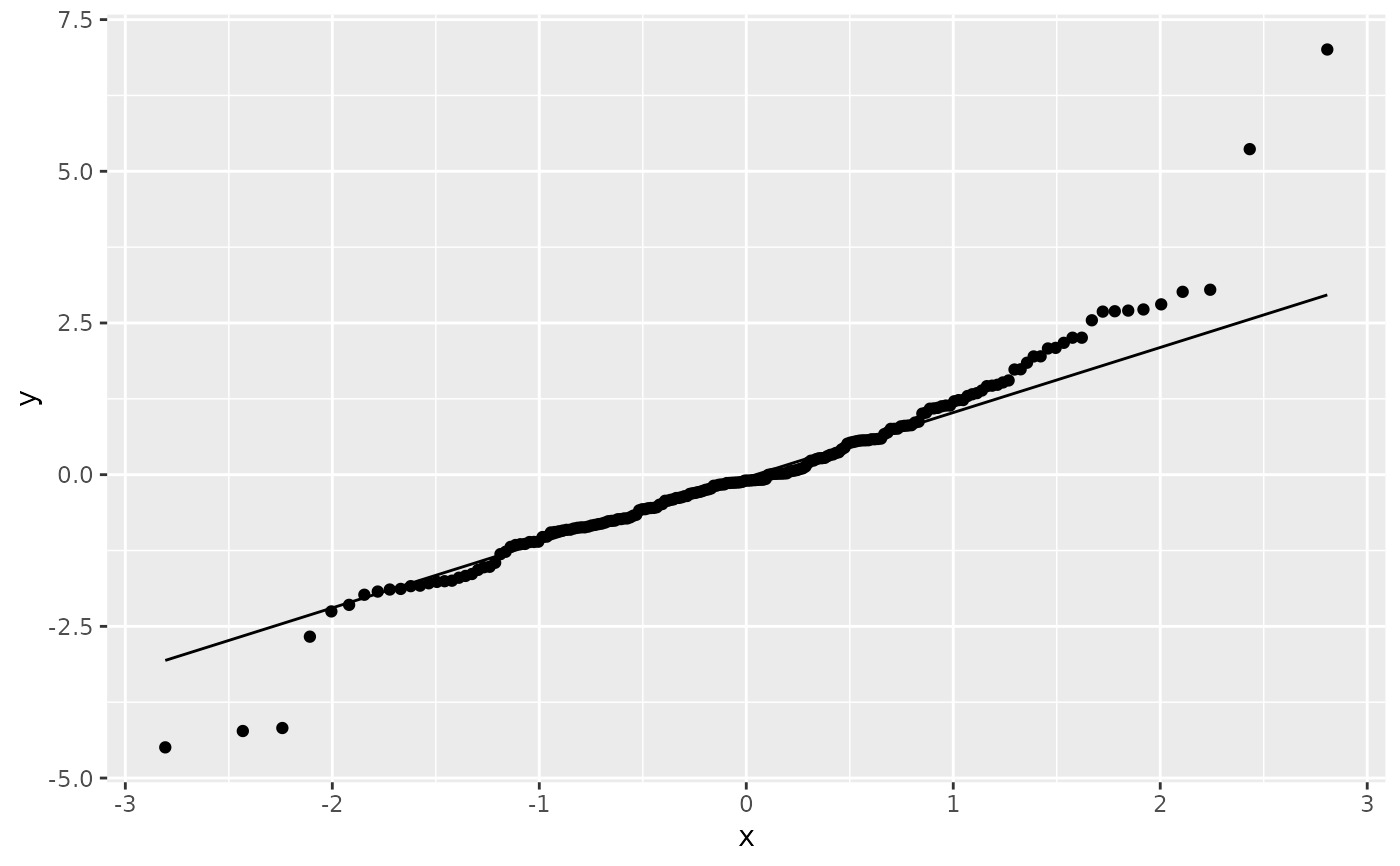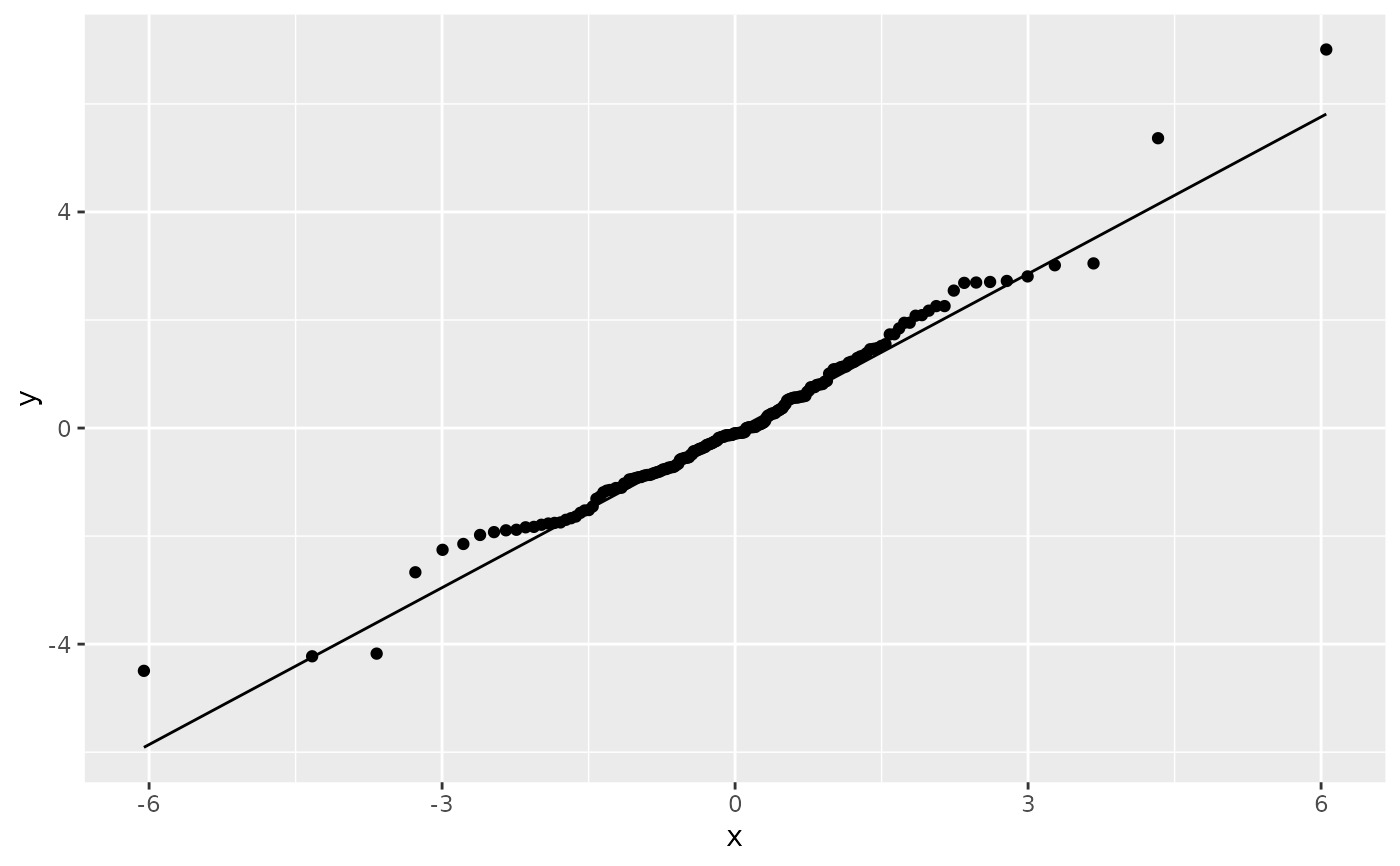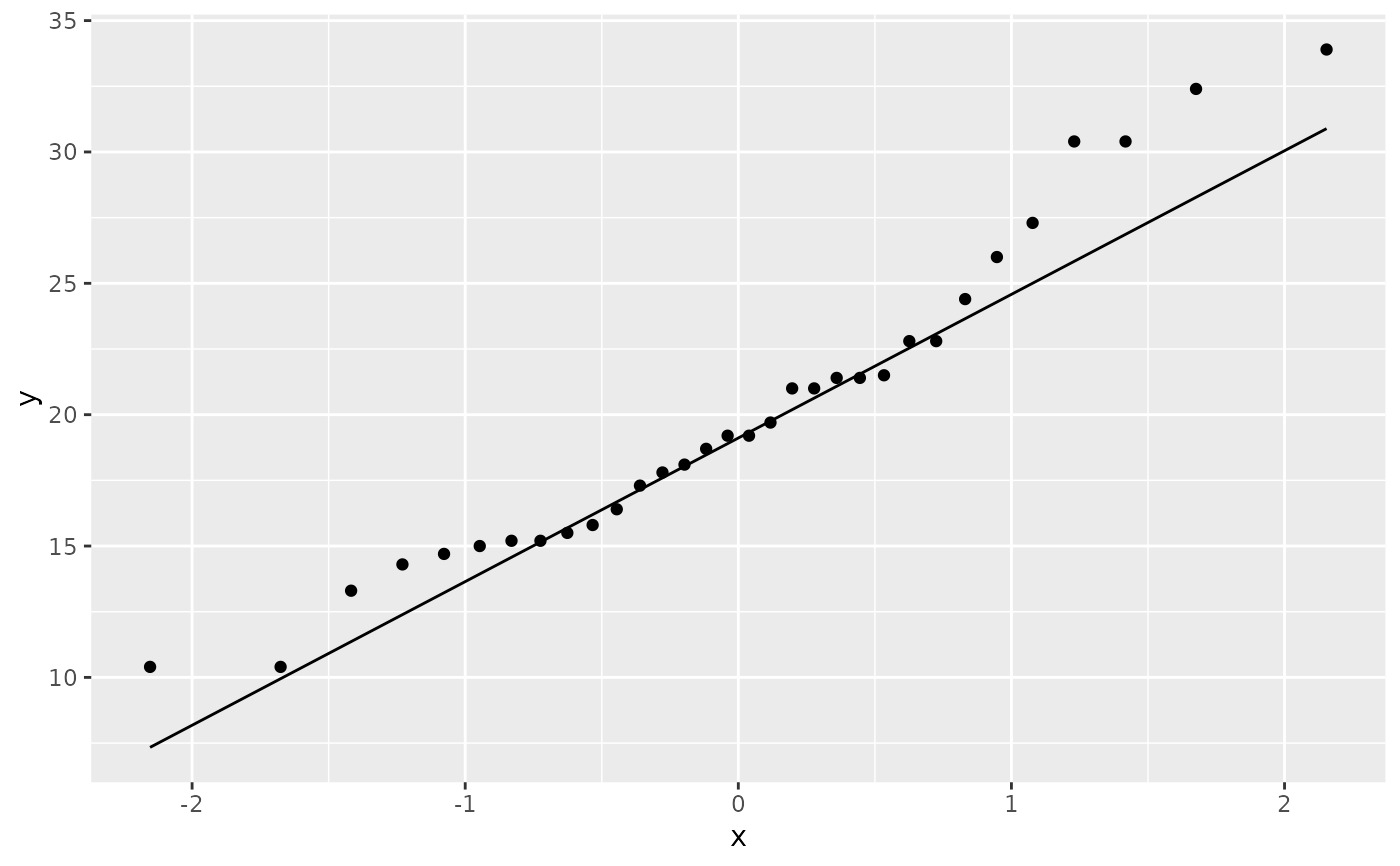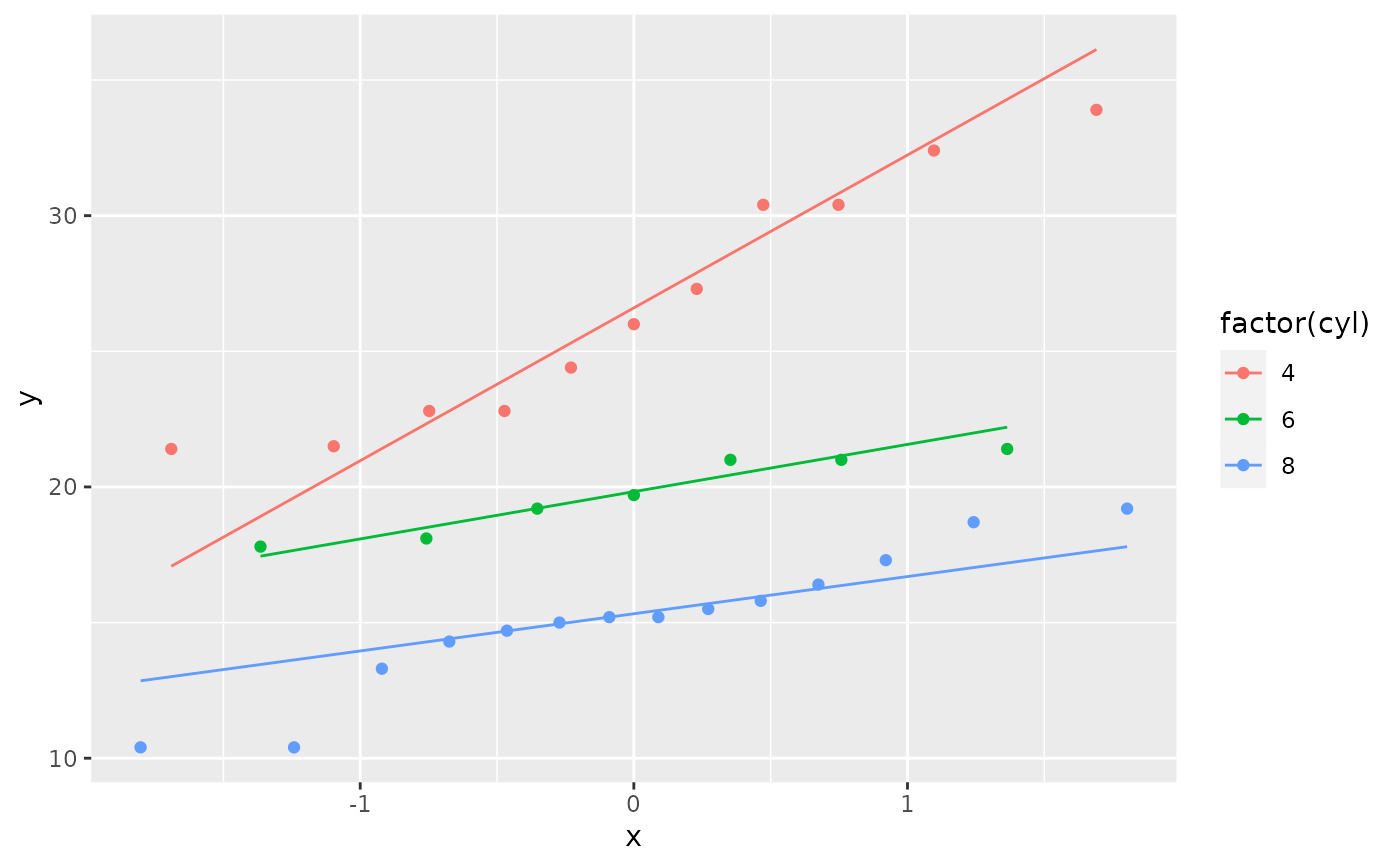geom_qq() 和 stat_qq() 生成 quantile-quantile 繪圖。 geom_qq_line() 和 stat_qq_line() 計算連接理論分布和樣本分布指定四分位數處的點的直線的斜率和截距。
用法
geom_qq_line(
mapping = NULL,
data = NULL,
geom = "path",
position = "identity",
...,
distribution = stats::qnorm,
dparams = list(),
line.p = c(0.25, 0.75),
fullrange = FALSE,
na.rm = FALSE,
show.legend = NA,
inherit.aes = TRUE
)
stat_qq_line(
mapping = NULL,
data = NULL,
geom = "path",
position = "identity",
...,
distribution = stats::qnorm,
dparams = list(),
line.p = c(0.25, 0.75),
fullrange = FALSE,
na.rm = FALSE,
show.legend = NA,
inherit.aes = TRUE
)
geom_qq(
mapping = NULL,
data = NULL,
geom = "point",
position = "identity",
...,
distribution = stats::qnorm,
dparams = list(),
na.rm = FALSE,
show.legend = NA,
inherit.aes = TRUE
)
stat_qq(
mapping = NULL,
data = NULL,
geom = "point",
position = "identity",
...,
distribution = stats::qnorm,
dparams = list(),
na.rm = FALSE,
show.legend = NA,
inherit.aes = TRUE
)參數
- mapping
-
由
aes()創建的一組美學映射。如果指定且inherit.aes = TRUE(默認),它將與繪圖頂層的默認映射組合。如果沒有繪圖映射,則必須提供mapping。 - data
-
該層要顯示的數據。有以下三種選擇:
如果默認為
NULL,則數據繼承自ggplot()調用中指定的繪圖數據。data.frame或其他對象將覆蓋繪圖數據。所有對象都將被強化以生成 DataFrame 。請參閱fortify()將為其創建變量。將使用單個參數(繪圖數據)調用
function。返回值必須是data.frame,並將用作圖層數據。可以從formula創建function(例如~ head(.x, 10))。 - geom
-
用於顯示數據的幾何對象,可以作為
ggprotoGeom子類,也可以作為命名去除geom_前綴的幾何對象的字符串(例如"point"而不是"geom_point") - position
-
位置調整,可以是命名調整的字符串(例如
"jitter"使用position_jitter),也可以是調用位置調整函數的結果。如果需要更改調整設置,請使用後者。 - ...
-
其他參數傳遞給
layer()。這些通常是美學,用於將美學設置為固定值,例如colour = "red"或size = 3。它們也可能是配對的 geom/stat 的參數。 - distribution
-
如果未指定 x,則要使用的分布函數
- dparams
-
傳遞給
distribution函數的其他參數。 - line.p
-
擬合 Q-Q 線時使用的分位數向量,默認為
c(.25, .75)。 - fullrange
-
q-q 線應該跨越繪圖的整個範圍,還是僅跨越數據
- na.rm
-
如果
FALSE,則默認缺失值將被刪除並帶有警告。如果TRUE,缺失值將被靜默刪除。 - show.legend
-
合乎邏輯的。該層是否應該包含在圖例中?
NA(默認值)包括是否映射了任何美學。FALSE從不包含,而TRUE始終包含。它也可以是一個命名的邏輯向量,以精細地選擇要顯示的美學。 - inherit.aes
-
如果
FALSE,則覆蓋默認美學,而不是與它們組合。這對於定義數據和美觀的輔助函數最有用,並且不應繼承默認繪圖規範的行為,例如borders()。
美學
stat_qq() 理解以下美學(所需的美學以粗體顯示):
-
sample -
group -
x -
y
在 vignette("ggplot2-specs") 中了解有關設置這些美學的更多信息。
stat_qq_line() 理解以下美學(所需的美學以粗體顯示):
-
sample -
group -
x -
y
在 vignette("ggplot2-specs") 中了解有關設置這些美學的更多信息。
計算變量
這些是由層的 'stat' 部分計算的,可以通過以下方式訪問ggplot2 aes_eval.
計算變量stat_qq():
-
after_stat(sample)
樣本分位數。 -
after_stat(theoretical)
理論分位數。
由 stat_qq_line() 計算的變量:
-
after_stat(x)
連接理論分布和樣本分布的選定分位數處的點的線段端點的 x 坐標。 -
after_stat(y)
端點的 y 坐標。
例子
# \donttest{
df <- data.frame(y = rt(200, df = 5))
p <- ggplot(df, aes(sample = y))
p + stat_qq() + stat_qq_line()
 # Use fitdistr from MASS to estimate distribution params
params <- as.list(MASS::fitdistr(df$y, "t")$estimate)
#> Warning: NaNs produced
#> Warning: NaNs produced
#> Warning: NaNs produced
ggplot(df, aes(sample = y)) +
stat_qq(distribution = qt, dparams = params["df"]) +
stat_qq_line(distribution = qt, dparams = params["df"])
# Use fitdistr from MASS to estimate distribution params
params <- as.list(MASS::fitdistr(df$y, "t")$estimate)
#> Warning: NaNs produced
#> Warning: NaNs produced
#> Warning: NaNs produced
ggplot(df, aes(sample = y)) +
stat_qq(distribution = qt, dparams = params["df"]) +
stat_qq_line(distribution = qt, dparams = params["df"])
 # Using to explore the distribution of a variable
ggplot(mtcars, aes(sample = mpg)) +
stat_qq() +
stat_qq_line()
# Using to explore the distribution of a variable
ggplot(mtcars, aes(sample = mpg)) +
stat_qq() +
stat_qq_line()
 ggplot(mtcars, aes(sample = mpg, colour = factor(cyl))) +
stat_qq() +
stat_qq_line()
ggplot(mtcars, aes(sample = mpg, colour = factor(cyl))) +
stat_qq() +
stat_qq_line()
 # }
# }
相關用法
- R ggplot2 geom_quantile 分位數回歸
- R ggplot2 geom_spoke 由位置、方向和距離參數化的線段
- R ggplot2 geom_text 文本
- R ggplot2 geom_ribbon 函數區和麵積圖
- R ggplot2 geom_boxplot 盒須圖(Tukey 風格)
- R ggplot2 geom_hex 二維箱計數的六邊形熱圖
- R ggplot2 geom_bar 條形圖
- R ggplot2 geom_bin_2d 二維 bin 計數熱圖
- R ggplot2 geom_jitter 抖動點
- R ggplot2 geom_point 積分
- R ggplot2 geom_linerange 垂直間隔:線、橫線和誤差線
- R ggplot2 geom_blank 什麽也不畫
- R ggplot2 geom_path 連接觀察結果
- R ggplot2 geom_violin 小提琴情節
- R ggplot2 geom_dotplot 點圖
- R ggplot2 geom_errorbarh 水平誤差線
- R ggplot2 geom_function 將函數繪製為連續曲線
- R ggplot2 geom_polygon 多邊形
- R ggplot2 geom_histogram 直方圖和頻數多邊形
- R ggplot2 geom_tile 矩形
- R ggplot2 geom_segment 線段和曲線
- R ggplot2 geom_density_2d 二維密度估計的等值線
- R ggplot2 geom_map 參考Map中的多邊形
- R ggplot2 geom_density 平滑密度估計
- R ggplot2 geom_abline 參考線:水平、垂直和對角線
注:本文由純淨天空篩選整理自Hadley Wickham等大神的英文原創作品 A quantile-quantile plot。非經特殊聲明,原始代碼版權歸原作者所有,本譯文未經允許或授權,請勿轉載或複製。
